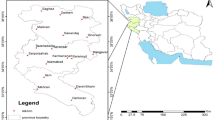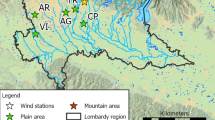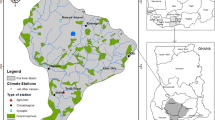Abstract
In this study, in order to downscaling the wind speed variablilitye in Zabol station (as a representative of Sistan region), SDSM and change factor (Delta) models were used and the results of both models were compared with each other. For this purpose, monthly and daily average wind speed data of Zabol station, and average wind speed data of the Coupled Global Climate Model Version 3 (CGCM3) under A1B, A2 and B1 scenarios and Canadian Earth System Model (CanESM2) under RCP2.6, RCP4.5 and RCP8.5 scenarios for the periods 2039 − 2010, 2069 − 2040 and 2099 − 2070 were used and the output of both models were compared with each other. The results showed that the output of the CGCM3 model under scenario A2 in the Delta model is more conformity with the base period. The output results of CGCM3 and CanESM2 models showed that the average wind speed will increase in the studied periods. The SDSM model under scenarios A1B and A2 predicted an increase in average wind speeds by 2099 of 0.41 and 0.95 m/s, respectively. The Delta model also predicted an average increase in wind speed by 2099 under scenarios A1B, A2 and B1, 0.57, 0.62 and 0.52 m/s, respectively. The results showed that at Zabol station, the Delta model simulated the average wind speed data better than the SDSM model (under scenarios A1B, A2 and B1), but the accuracy of the CanESM2 model is more than other models.














Similar content being viewed by others
References
Abbasi F, Asmari M (2011) Forecasting and assessment of climate change over Iran during future decades by using MAGICC-SCENGEN model. J Water Soil 25(1):70–83
Aghashahi M (2012) Introduction and comparison of LARS-WG and SDSM models for downscaling of environmental parameters in climate change studies, Proceedings of the 6th National Conference on Environmental Engineering, Tehran, University of Tehran, Faculty of Environment
Akhavan S, Ghabaei Sough M, Mosaedi A (2016) Investigation of the effect of climate change on net irrigation requirement of main crops of Hamadan-Bahar plain using LARS-WG downscaling model. J Water Soil Conserv 22(4):25–46
Ashraf B, Mousavi Baygi M, Kamali M, Davari K (2011) Prediction of seasonal variations of climatological parameters over next 20 years by using statistical downscaling method of HadCM3 data. J Water Soil 25(4):945–957
Azizi GH, Shamsipour A, Yarahmadi D (2009) Detection climate change using multivariable statistical analysis in west of Iran. Phys Geogr Res Q 66:19–35
Babaian I (2014) A brief introduction to the SDSM statistical downscaling model,Climate Dialogue Blog. https://climatology.ir/?p=1328
Baranpour M, Khalili Moghadam B, Zoratipour A (2021) Evaluation of the performance of SDSM and LARSWG statistical downscaling models for quantitative screening in predicting climate scenarios (Case study: Dust center south and southeast of Ahvaz). Hydrogeomorphology 8(28):107–126. doi: https://doi.org/10.22034/hyd.2021.45686.1586
Chu JT, Xia J, Xu CY, Singh VP (2010) Statistical downscaling of daily mean temperature, pan evaporation and precipitation for climate change scenarios in Haihe River. China. Theoret Appl Climatol 99(1–2):149–161
Coulibaly P, Yonas B (2005) Downscaling precipitation and temperature with temporal neural networks. Am Meterology socity 6:483–496
Daneshfaraz R, Razzaghpour H (2014) Assessment of Climate Change Effects on Potential Evapotranspiration in West Azarbaijan Province Iran. J Geographic space 46:323–333
Dibike YB, Coulibaly P (2005) Hydrologic impact of climate change in the Saguenay watershed: comparison of downscaling methods and hydrologic models. J Hydrol 307(1):145–163
Etemadi H, Samadi SZ, Sharifikia M (2012) Statistical Downscaling of Climatic Variables in Shadegan Wetland. Iran 1:508. 10.4172/ scientificreports.508
Farzaneh MR, Samadi SZ, Akbarpour A, Islamian SS (2010) Introduction of selected predictors for small-scale statistical-regression in Beheshtabad Karun North Karun Basin, the first conference on applied research of water resources Iran, Kermanshah, Kermanshah University of Technology
Ghasemi A, Saiedi F (2015) Simulation of changes and wind speed forecasting in Iran. Q J Geographical Inform 94:95–105
Goubanova K, Echevin V, Dewitte B, Codron F, Takahashi K, Terray P, Vrac M (2011) Statistical downscaling of sea-surface wind over the Peru–Chile upwelling region: diagnosing the impact of climate change from the IPSL-CM4 model. Clim Dyn 36(7–8):1365–1378
Goudarzi M, Salahi B, Hosseini SA (2018) Estimation of Evapotranspiration Rate Due to Climate Change in the Urmia Lake Basin Iranian. J Watershed Manage Sci Eng 13(41):1–12
Gutierrez JM, San-Martín D, Brands S, Manzanas R, Herrera S (2013) Reassessing Statistical Downscaling Techniques for Their Robust Application under Climate Change Conditions. J Clim 26:171–188
Hamidianpour M, Mofidi A, Saliqeh M (2016) Analysis of the nature and structure of Sistan wind. Iran J Geophys 10:83–109
Hamidianpour M, Saliqeh M, Fallah Q Gh (2012) Application of various interpolation methods for spatial monitoring and analysis of drought (Case study of Khorasan Razavi province). Geogr Dev 30:57–70
Harmel RD, Richardson CW, Hanson CL, Johnson GL (2002) Evaluating the adequacy of simulating maximum and minimum daily air temperature with the normal distribution. J Appl Meteorol 41(7):744–753
Hassan WH, Nile BK (2021) Climate change and predicting future temperature in Iraq using CanESM2 and HadCM3 modeling. Model Earth Syst Environ 7:737–748. https://doi.org/10.1007/s40808-020-01034-y
Hossein Y, Amini L, Ghasemi L, Amrai N (2018) Evaluation of the efficiency of statistical downscaling model (SDSM) in simulation and forecast of climatic parameters (case study: Karaj synoptic station). Iran J Eco Hydrology 5(3):957–968
Khan MS, Coulibaly P, Dibike Y (2006) Uncertainty analysis of statistical downscaling methods using Canadian Global Climate Model predictors. Hydrology Process 20:3085–3104
Khordadi MJ, Islamian SS, Abedi Kopali J (2007) Investigation of meteorological parameters in several regions of Iran. Technical workshop on the effects of climate change in water resources management. Tehran, National Committee for Irrigation and Drainage
Khosravi M (2008) Environmental Impacts of the Interaction of Helmand River Fluctuations with 120-Day Winds. Geographical Res Q 99:19–48
Koch M, Cherie N (2013) Monoand multi-modal statistical downscaling of GCM-climate predictors for the Upper Blue Nile River basin, Ethiopia. In Proceedings of the 6 th International Conference on Water Resources and Environment Research, ICWRER (pp. 3–7)
Koukidis EN, Berg AA (2009) Sensitivity of the Statistical DownScaling Model (SDSM) to reanalysis products. Atmos Ocean 47(1):1–18
Liu B, Costa KB, Xie L, Semazzi FH (2014) Dynamical Downscaling of Climate Change Impacts on Wind Energy Resources in the Contiguous United States by Using a Limited-Area Model with Scale-Selective Data Assimilation. Advances in Meteorology, Special Issue, https://doi.org/10.1155/2014/897246
Liu L, Liu Z, Ren X, Fischer T, Xu Y (2011) Hydrological impacts of climate change in the Yellow River Basin for the 21st century using hydrological model and statistical downscaling model. Quatern Int 244(2):211–220
McKague K, Rudra R, Ogilvie J (2003) CLIMGEN-A Convenient Weather Generation tool for Canadian Climate Stations. Canadian society for engineering in agricultural food and biological systems. Quebec, Montreal, pp 1–26
Mearns LO, Giorgi F, Whetton P, Pabon D, Hulme M, Lal M (2003) Guidelines for use of climate scenarios developed from regional climate model experiments. www.ipcc-data.org/guidelines/dgm_no1_v1_10-2003.pdf
Mehrazar A, Massah Bavani A, Mashal M, Rahimikhoob H, Iran (2018) J, Irrigation Sciences and Engineering, 41(3): 45–59
Mirakbari M, Mesbahzadeh T, Mohseni Saravi M, Khosravi H, Mortezaie Farizhendi G (2018) Performance of series model cmip5 in simulation and projection of climatic variables of rainfall, temperature and wind speed (Case Study: Yazd). Phys Geogr Res Q 50(3):593–609
Mofidi A, Hamidianpour M, Saliqeh M, Alijani B (2013) Determining the time of beginning, end and duration of Sistan wind by using the methods of estimating the point of change. Geogr Environ hazards 8:87–112
Mohammed ZM, Hassan WH (2022) Climate change and the projection of future temperature and precipitation in southern Iraq using a LARS-WG model. Model Earth Syst Environ. https://doi.org/10.1007/s40808-022-01358-x
Moses O, Gondwe M (2019) Simulation of changes in the twenty-first century maximum temperatures using the statistical downscaling model at some stations in Botswana. Model Earth Syst Environ 5:843–855. https://doi.org/10.1007/s40808-019-00571-5
Pichuka S, Maity SS, Maity R (2021) Benefit of time-varying downscaling model for the assessment of urban temperature rise. Model Earth Syst Environ. https://doi.org/10.1007/s40808-021-01239-9
Pryor SC, Schoof JT, Barthelmie RJ (2005) Climate change impacts on wind speeds and wind energy density in northern Europe: empirical downscaling of multiple AOGCMs. Climate Res 29(3):183–198
Quan J, Shang L (2021) An Ensemble Model of Wind Speed Forecasting Based on Variational Mode Decomposition and Bare-Bones Fireworks Algorithm. Math Probl Eng 2021:1–16. https://doi.org/10.1155/2021/6632390
Rahimzadeh F, Fattahi E, Hosseini Dastak SF (2005) A Study of Climate Variability in Iran Using Statistical Models. Bi-Quarterly J Iran Water Resour Res 2:61–73
Rajabi A, Sedghi H, Eslamian S, Musavi H (2010) Comparison of Lars-WG and SDSM downscaling models in Kermanshah (Iran). Ecol Env & Cons 16(4):465–474
Rasouli A, Rezaei-Banafsheh M, Massah AR, Khorshiddoust AM, Ghermezcheshmeh B (2014) Investigation Impact of Morpho-Climatic Parameters on accuracy of LARS-WG Model. Iran Watershed Manage Sci Eng 8(24):9–19
Rezaei M, Nahtani M, Abkar A, Rezaei M, Mirkazehirigi M (2015) Performance evaluation of statistical downscaling model (SDSM) in forecasting temperature indexes in two arid and hyper arid regions (Case Study: Kerman and Bam). Watershed Manage Res J 5(10):117–131
Sailor DJ, Hu T, Li X, Rosen JN (2000) A neural network approach to local downscaling of GCM output for assessing wind power implications of climate change. Renewable Energy 19(3):359–378
Salameh T, Drobinski P, Vrac M, Naveau P (2009) Statistical downscaling of near-surface wind over complex terrain in southern France. Meteorol Atmos Phys 103(1–4):253–265
Sayari N, Alizadeh A, Bannayan Awal M, Farid Hossaini A, Hesami Kermani MR (2011) Comparison of two GCM models (HadCM3 and CGCM2) for the prediction of climate parameters and crop water use under climate change (Case Study: Kashafrood Basin). J Water Soil 25(4):912–925
Sedaghatkerdar A, Fattahi E (2008) Drought Forecasting Indicators in Iran. J Geogr Dev 6(11):59–76
Shang Z, Wen Q, Chen Y, Zhou B, Xu M (2022) Wind Speed Forecasting Using Attention-Based Causal Convolutional Network and Wind Energy Conversion. Energies 2022, 15, 2881. https://doi.org/10.3390/en15082881
Taei Samiromi S, Moradi H, Khodagholi M (2014) Simulation and Prediction of Some Climatic Variables by SDSM Multiple Linear Model of Barley Circulation Models (Case Study of Neishabour Watershed). Q Man Environ 39:1–15
Tatari F, Mazouchi M (2017) Hourly wind speed prediction using arma model and artificial neural networks. Int J Smart Electr Eng 6(3):107
Tatsumi K, Oizumi T, Yamashiki Y (2013) Introduction of daily minimum and maximum temperature change signals in the Shikoku region using the statistical downscaling method by GCMs. Hydrol Res Lett 7(3):48–53
Varis O, Kajander T, Lemmela R (2004) Climate and water: From climate models to water resources management and vice versa. Climare Change 66:321–344
Wang TA (2021) combined model for short-term wind speed forecasting based on empirical mode decomposition, feature selection, support vector regression and cross-validated lasso. PeerJ Comput Sci. 24;7:e732. doi: https://doi.org/10.7717/peerj-cs.732. PMID: 34712801; PMCID: PMC8507474
Wilby RL, Dawson CW, Barrow EM (2002) SDSM-a decision support tool for the assessment of regional climate change impacts.Environmental Modelling &Software, (17):147–159
Wilby RL, Dawson WC (2007) SDSM 4.2- A decision support tool for the assessment of regional climate change impacts, SDSM manual version 4.2, Environment Agency of England and Wales, 94 pp
Wilby RL, Tomlinson OJ, Dawson WC (2003) Multi-site simulation of precipitation by resampling. J Clim Res 23:183–194
Zhang XC, Liu WZ, Chen J (2011) Trend and uncertainty analysis of simulated climate change impacts with multiple GCMs and emission scenarios. Agric For Meteorol 151:1297–1304
Author information
Authors and Affiliations
Corresponding author
Additional information
Publisher’s note
Springer Nature remains neutral with regard to jurisdictional claims in published maps and institutional affiliations.
Rights and permissions
About this article
Cite this article
Salahi, B., Poudineh, E. An evaluation of Delta and SDSM Downscaling Models for simulating and forecasting of average wind velocity in Sistan, Iran. Model. Earth Syst. Environ. 8, 4441–4453 (2022). https://doi.org/10.1007/s40808-022-01431-5
Received:
Accepted:
Published:
Issue Date:
DOI: https://doi.org/10.1007/s40808-022-01431-5




